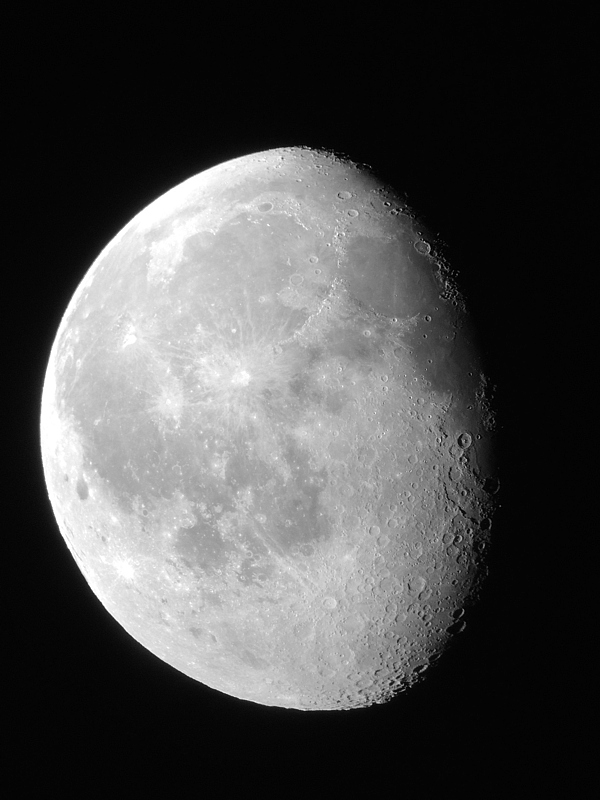Power Outage, Jupiter Moon Ganymede Occults Io
Posted: 10 March 2015
|
Open: Monday, 9 March 2015, 1817 MST Temperature: 77°F |
Session: 791 Conditions: Mostly clear |
First, the observatory clock was SYNCed to WWV for the night's Jovian Moons Mutual Event (Ganymede occulting Io).
1829 MST: sunset. Viewed Venus, 83X. Nice gibbous phase view against bright blue sky.
Did some POD maintenance; recentered dome wheels axles, something I had not done for a couple of years.
1839 MST: area wide power outage!! Argh!
Set up telescope in polar home position in preparation for realigning the AutoStar after the power came back on. Then, as the outage continued, I returned to the house to shutdown computers, which had been on their UPSes. On my way back to the observatory I saw a Great Horned Owl in a tree along the pathway. The owl flew away before I could get a photograph.
1902 MST: still no electricity. 1918 MST: Zodiacal Light becoming visible. Astronomical Twilight would not end until 1949 MST. I began just enjoying the view of the night sky from my dark sky site while waiting (hoping) for the power to return. Had our Federal Government run electric utility company told us they were going to turn the power off this night I would have charged up my PowerTank 12VDC power supply or used one of my other telescopes for some of my planned activities this night.
1945 MST: decided to do some observing with my 12x70 binoculars. Viewed the Double Cluster, Owl Cluster, and Comet C/2014 Q2 (Lovejoy) in Cassiopeia. I hadn't viewed Comet Lovejoy since January 2015; it was still a nice sight in the binoculars. Also viewed M45 (Pleiades), M42 (Orion Nebula), Jupiter (only one moon was visible; Callisto), and several open star clusters. While I was viewing two open clusters, a meteor passed through the binoculars field-of-view. Neat.
2011 MST: power outage continued. Returned to the house to get the SQM-L meter and do some sky quality measurements. Got a reading of 21.13.
2027 MST: still no power, so decided to close the observatory.
2040 MST: closed.
2150 MST: after two false starts, the power came back on a few minutes earlier, and I re-opened the observatory. I rechecked the observatory clock since it had been running on battery backup; it was still correct. I then realigned the AutoStar. 2209 MST: alignment complete. The eastern sky was beginning to brighten from the rising waning gibbous moon. Due to the extended power outage, I was unable to do all the DSO imaging I had planned for this night. Rats.
Viewed Jupiter, 83X. Three moons were visible (Callisto, Europa, and Io). The shadow of Ganymede was seen in transit across the planet's disk. 2219 MST: switched to 222X. Ganymede itself was visible against the planet's bright disk. I began setting up to image Jupiter with the hope of capturing Ganymede and its shadow. Unfortunately I was running out of time to catch Ganymede as its transit would end at 2236 MST. And as tonight's luck would have it, by the time I was ready to image Jupiter, it was in my observatory dome "zenith blind spot". Argh.
2251 MST: did a focus test on the star Procyon using the Bahtinov Mask with the D7000 DSLR at prime focus + 3X TeleNegative. I then had to change the batteries in the Wireless AutoStar II handcontroller.
2301 MST: finally got Jupiter in the camera viewfinder. I discovered that GOTOs were not very good. Would have to re-align the AutoStar after the Mutual Event was over. Ganymede was now visible off the planet. Grumble. 2305 MST: took this iPhone photo of the D7000 DSLR Live View screen showing Ganymede's shadow on the planet:

2313 MST: this (cropped) DSLR image, 1/30sec, ISO 6400, shows three moons:

2316 MST: everything was ready for the Jovian Moons Mutual Event. Ganymede would begin occulting Io at 233031 MST, ending at 233551 MST. The magnitude change would be 0.6. 2318 MST: Ganymede shadow easily seen in camera viewfinder.
This sequence, 1/30sec, ISO 6400, prime focus + 3X TeleNegative shows the changing positions of Ganymede and Io:
Prior to occultation, Io on the right:

Mid-occultation, only Ganymede visible:

End of occultation, Ganymede on the right:

2345 MST: selected to GOTO to the moon, low in the southeastern sky. The telescope ended up pointing to the northeast. Argh. I discovered that the DEC lock had become loose at some point, likely right after I did the alignment following the power restoration. I removed the camera and redid the polar alignment, ensuring that the DEC lock was tight. 2359 MST: alignment complete and GOTOs were good. Whew.
Viewed Jupiter, 83X. Ganymede shadow still visible in transit. Slewed to the moon, which was just rising out of a tree. 0006 MST: took this handheld iPhone 5s afocal 83X photo of the moon:

0010 MST: switched to 222X and did some lunar observing. Some nice sights along the terminator.
I then began closing up. What a crazy night.
|
Close: Tuesday, 10 March 2015, 0023 MST Temperature: 55°F |
|
Comments are welcome using Email. If you are on Twitter you can use the button below to tweet this report to your followers. Thanks.
Cassiopeia Observatory Home Page
Copyright ©2015 Michael L. Weasner / mweasner@me.com
URL = http://www.weasner.com/co/Reports/2015/03/10/index.html
